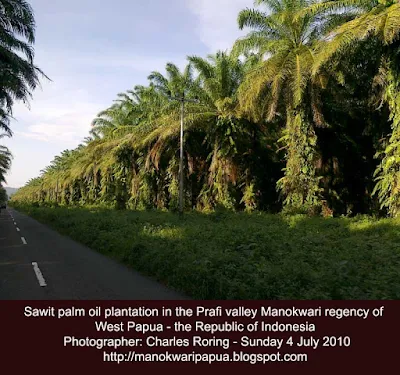Articles about Wasior can be seen on the following links:
Through this blog post, I want to express my condolences to all the victims of Wasior flood. I hope that God will strengthen them through this difficult times. We must see this disaster as a very expensive lesson so that we will be more aware of the preservation of nature both in the mountains and at sea.
Wasior town - the capital of Cendrawasih bay regency, had just received special guests from the Netherlands on 20 - 21 July 2010. The Cendrawasih or Geelvink bay is the largest National Marine Park in Indonesia occupying 1.45 million hectares of lands and sea areas. The waters of the park has pristine coral reefs whereas the islands of park is still covered with dark green tropical rainforest. These guests were the Labrees from the Netherlands- a beautiful country in Europe that is famous for its Tulip flowers and windmills. They were accompanied by Paul Gasper, a local Papuan tourist guide who can speak Dutch. The Labree family visited Wasior because this town was the birthplace of Mr. (Jan) Labree. While in Wasior, they tried to find a house where he used to live. As a matter of fact, it was not easy to find the house. Fortunately, Mr. Labree still had the video or photograph of his old house. When it was shown to a local Papuan who live in Wasior, he could recognize it and helped them find it. It was a happy and emotional day for the Labree family when finally they saw the house.
- Wasior town before the October 2010 flood video
- Wasior town before the October 2010 Flood article and photographs
- Tropical rainforest in mountains and islands around Wasior
Through this blog post, I want to express my condolences to all the victims of Wasior flood. I hope that God will strengthen them through this difficult times. We must see this disaster as a very expensive lesson so that we will be more aware of the preservation of nature both in the mountains and at sea.
Wasior town - the capital of Cendrawasih bay regency, had just received special guests from the Netherlands on 20 - 21 July 2010. The Cendrawasih or Geelvink bay is the largest National Marine Park in Indonesia occupying 1.45 million hectares of lands and sea areas. The waters of the park has pristine coral reefs whereas the islands of park is still covered with dark green tropical rainforest. These guests were the Labrees from the Netherlands- a beautiful country in Europe that is famous for its Tulip flowers and windmills. They were accompanied by Paul Gasper, a local Papuan tourist guide who can speak Dutch. The Labree family visited Wasior because this town was the birthplace of Mr. (Jan) Labree. While in Wasior, they tried to find a house where he used to live. As a matter of fact, it was not easy to find the house. Fortunately, Mr. Labree still had the video or photograph of his old house. When it was shown to a local Papuan who live in Wasior, he could recognize it and helped them find it. It was a happy and emotional day for the Labree family when finally they saw the house.
After staying for one and a half days in Wasior, the Labrees flew back to Manokwari. Here, they have a 4-day tour around Manokwari city.
Yesterday, I accompanied the Labree family traveling around the Mansinam and Lemon islands. We went snorkeling to see the beautiful coral reef and ornamental fish in the surrounding waters and the cross monument of Ottow and Geissler. While snorkeling, we could see urchin, blue fish and various kinds of colourful corals. Corals need at least twenty years to reach a size similar to a human head. In addition, We were also very lucky because we could see a rare baby tridachna gigas or giant clamp. It was located at the slope of the sea bed, some 6 meters under the surface. I wish I could show you the picture of the baby giant clamp. I do not have underwater camera.
On the afternoon, after swimming and snorkeling, we continued our trip to Mansinam village where we met the villagers and Peter Rumbruren, a Papuan artist who makes artworks mostly from wood. We were very thirsty and hungry. Peter was very kind to us. He provided us some coconuts and bananas. Peter has a small hut which he built in front of his house as an art gallery. He puts all of his artworks inside this "gallery" that is a replica of a traditional Papuan house. Mr. Labree bought a wooden Korwar statue from this artist as a souvenir for his relatives. All tourists who bought souvenirs from Papuan artists have directly support our efforts in developing eco-tourism project that is aimed at improving the living condition of the local Papuan people without destroying their natural environment. The Labrees will still be in Manokwari until 25 July 2010 and I still have some more stories about their travel experience and beauty of Papua's nature and the friendliness of the indigenous people. by Charles Roring




















